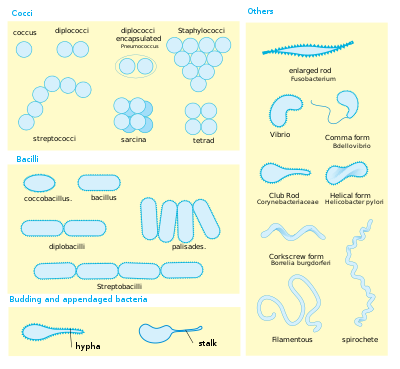
A bacillus (pl.: bacilli), also called a bacilliform bacterium or often just a rod (when the context makes the sense clear), is a rod-shaped bacterium or archaeon. Bacilli are found in many different taxonomic groups of bacteria. However, the name Bacillus, capitalized and italicized, refers to a specific genus of bacteria. The name Bacilli, capitalized but not italicized, can also refer to a less specific taxonomic group of bacteria that includes two orders, one of which contains the genus Bacillus. When the word is formatted with lowercase and not italicized, 'bacillus', it will most likely be referring to shape and not to the genus at all. Bacilliform bacteria are also often simply called rods when the bacteriologic context is clear.[1]
Bacilli usually divide in the same plane and are solitary, but can combine to form diplobacilli, streptobacilli, and palisades.[2]
- Diplobacilli: Two bacilli arranged side by side with each other.
- Streptobacilli: Bacilli arranged in chains.
- Coccobacillus: Oval and similar to coccus (circular shaped bacterium).[3]
There is no connection between the shape of a bacterium and its color upon Gram staining; there are both gram-positive rods and gram-negative rods. MacConkey agar can be used to distinguish among gram-negative bacilli such as E. coli and salmonella.[4]
YouTube Encyclopedic
-
1/3Views:8 45815 557682
-
Shapes of Prokaryotic Cells - Bacteria and Archaea Cells
-
Shape of bacteria | Coccus, Bacillus And Spiral | Class 11 Biology
-
Focusing a Microscope; Sizes, Shapes, Arrangements, and Forms of Bacteria
Transcription
Gram-positive examples
Gram-negative examples
- Bacteroides
- Citrobacter
- Enterobacter
- Escherichia
- Klebsiella
- Pseudomonas
- Proteus
- Salmonella
- Serratia
- Shigella
- Vibrio
- Yersinia
References
- ^ "The Size, Shape, And Arrangement Of Bacterial Cells". Midlands Technical College. Archived from the original on 9 August 2016. Retrieved 8 August 2016.
- ^ "Chapter 4: Functional Anatomy Of Prokaryotic And Eukaryotic Cells". Archived from the original on 23 September 2012.
- ^ Kaiser GE. "Sizes, Shapes, and Arrangements of Bacteria". The Community College of Baltimore County. Archived from the original on 11 August 2019. Retrieved 8 August 2016.
- ^ "Gram Negative Bacilli". NYU School of Medicine. Archived from the original on 14 March 2009.
